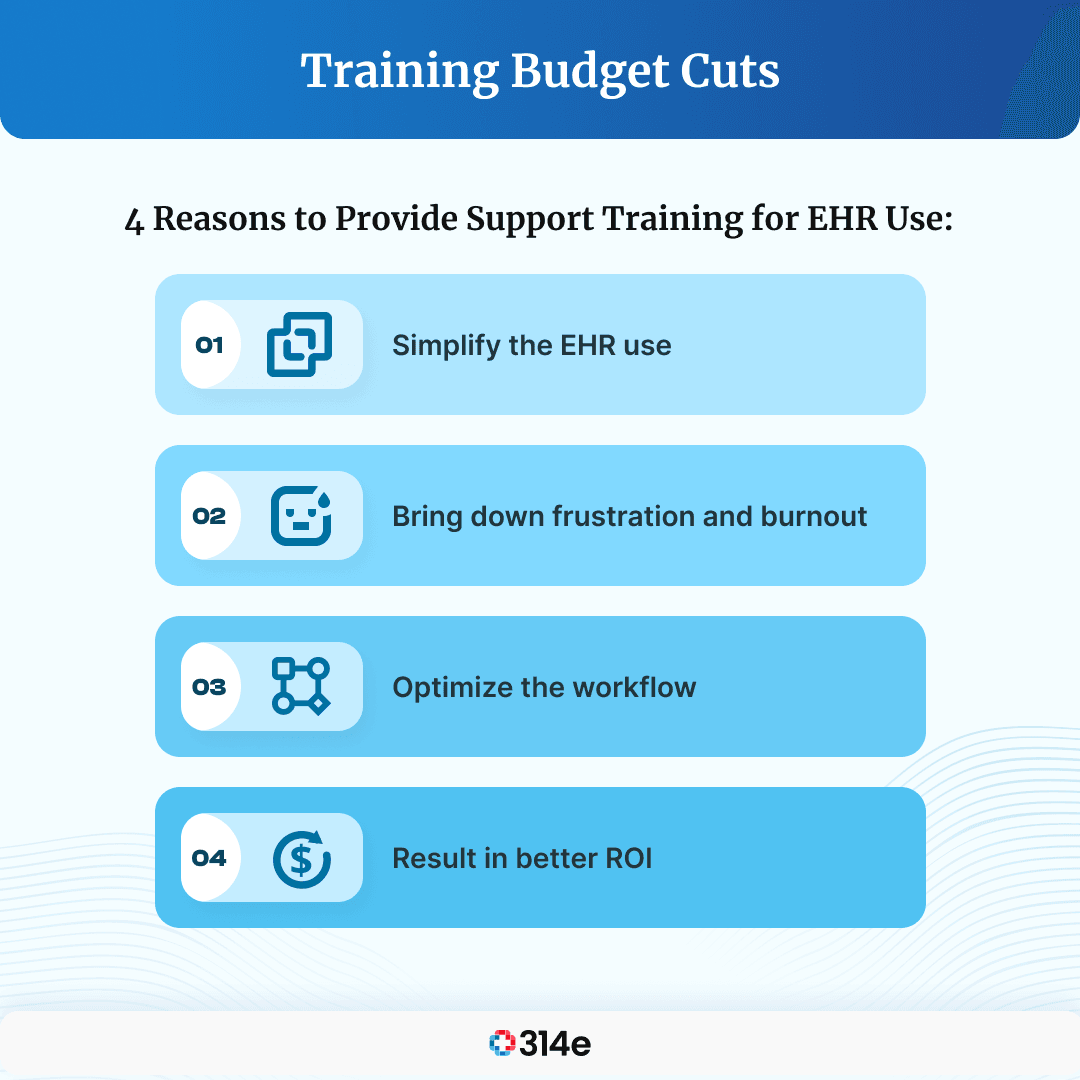
Importance of EHR Upgrades
As technology evolves, it is important for healthcare organizations to keep up with the latest trends in order …

The healthcare industry has been challenged to a great extent due to the global health crisis caused by COVID-19. Amidst challenges like workforce shortage and a dramatic increase in hospital and labor costs, training is something that faced a major hit during the pandemic.
In the digitalized world, healthcare requires the support of IT to ease the provision of care. EHRs are one of the key innovations in healthcare IT, introduced to eliminate medical reporting errors, improve privacy in health data sharing, and ultimately enhance health care quality. Training is of utmost importance to ensure optimum EHR efficiency; be it the implementation of a new one or the use of an existing one, EHR training and support training is crucial.
If your healthcare organization is facing training budget cuts, then go through this article to find out:
Once your EHR is live and running, your users will still need help working on the EHR, and this is where support training comes in handy.
While EHR training is indispensable to get started, support training is crucial to help users navigate better through EHRs. It refers to the key resources and tools provided to the user to enhance EHR usability. Support training helps users identify solutions to specific problems they encounter while working on EHRs. It could help a physician update their order inventory list, essentially something that they don’t do every day and thus forget. While EHR training always makes it to the training budget, it is the support training that is compromised in most cases.
The aspect of EHR support training is as important as any aspect of technology and design when it comes to EHR training, implementation, and adoption. Having the right support training strategy backed by a smart tool for EHR use could help your organization in the following ways:

Having difficulties with figuring out EHR use cases can cause a delay in getting things done. However, with support training easing the use of EHRs, users tend to become more confident about working on EHRs, which ultimately boosts morale and productivity and leads to higher satisfaction.
A recent study on "Association of EHR Use With Physician Fatigue and Efficiency" observed that 80% of physicians experienced fatigue within just the first 22 minutes of Electronic Health Record use. If not provided with the required support while working on EHRs, there is every chance that your user could experience frustration and fatigue, leading to burnout. The right support could reduce the chances of this happening and help the clinicians focus on providing care.
When your clinician/user has clarity on how to get things done on an EHR, it generally improves the process by eliminating documentation errors, speeding up productivity, and improving the quality of care provided.
With ongoing support training, all the investment in EHRs would be fruitful and reap results beneficial in the long run. In addition, support training increases the EHR use efficiency and helps with cost-saving for your healthcare organization.
In the times of COVID-19, the one thing we have learned the best is the importance of being prepared to handle any crisis. Training budget cuts can be risky for your healthcare organization as they undermine the user’s capability to confront the queries and compromise the use of EHRs to their optimum capacity. In addition, it can also affect the overall productivity of your clinician and increase their in-workflow burden.
The lack of the right support training could additionally add to the following EHR usability challenges:
Your clinician could struggle with getting simple tasks accomplished promptly because of the lack of the required workflow support. Something as simple as ordering a controlled substance for a trauma patient could take up a lot of unnecessary time and result in delays.
The time the clinician has to spend on patient care is taken up to quite some extent by the task of locating and getting things done on an EHR. Figuring things out on the EHR while putting patient care on hold just adds to the trouble and causes a cognitive load for the clinician.
A Primary Care Physician Workload Assessment study shows that physicians spend about 6 hours on EHRs during a usual 11-4 workday in which clerical tasks like order entry, documentation, billing, and coding take up about 44% of the time. Considering that quite a large part of a physician’s day is taken up by EHR use, without the right support, the difficulties with data entry could just get worse, and your physician would end up spending more time than usual on the EHR.
The best way to confront such challenges would be to have great support training that complements your implementation training and supplements LMS to reduce the need for additional in-person training.
Wondering how to nail support training strategy?
Here’s what you can do:
The best way to combat your training budget cuts would be to begin by democratizing the creation of support content. You no longer need to worry about having a dedicated team for creating content. Considering the shortage of resources, a great idea would be to include your super-users and subject matter experts (SMEs) in the content creation. They could prove to be your most efficient resource in the process as they possess exquisite knowledge about the tasks due to their everyday encounter.
The right support tool would simplify the support content creation process and cut costs. For example, it would help you record short “how-to” videos by capturing screencasts with voiceover without fancy equipment or extensive editing.
Do not forget to incorporate AI into your support training strategy. Artificial intelligence can help your organization beat the burden of discovery by identifying their application roles and suggesting searches that they might be trying to accomplish or showcasing resources that other similar users might frequently be using.
Now that you know how the right support training strategy can change the whole game for your organization, despite a training budget cut, here’s a quick guide to help you create effective training content in minutes.
When it comes to support, users expect a quick solution to a specific problem. Having swift, to-the-point content can save your users’ time and help with easy comprehension. If you are interested in upping the game with some engaging content, check out 4 Steps to Create a Microlearning Video.
Always put yourself in the user’s shoes while recording EHR training and support content. Understand the problems they might face while working on EHRs and figure out all the use cases that EHR training might have somehow missed.
It is good to remember that while your initial EHR training might have prepared your users for implementation, it is the upgrades that they aren’t prepared for. Therefore, the support content must ideally be thought through and created in such a way that it provides support while working with upgrades.
With the right strategy, supported by a smart tool and effective content, training budget cuts would certainly no longer affect your organization the way they did.
Let the journey of continuous support for EHRs begin!
Join over 3,200 subscribers and keep up-to-date with the latest innovations & best practices in Healthcare IT.

As technology evolves, it is important for healthcare organizations to keep up with the latest trends in order …

Electronic Health Records (EHRs) have ushered in a new era of healthcare, transforming patient care, data …

According to a recent study by the Annals of Family Medicine, clinicians spend nearly 90 minutes in their …